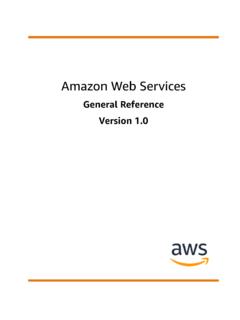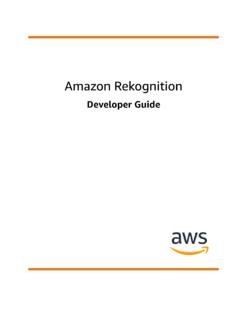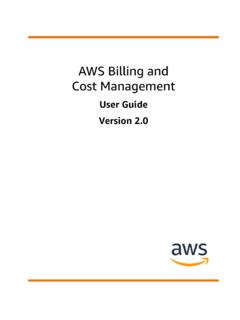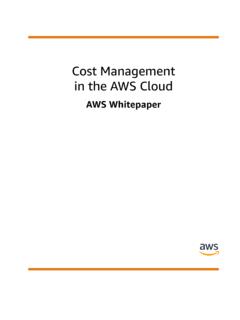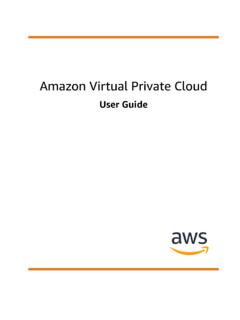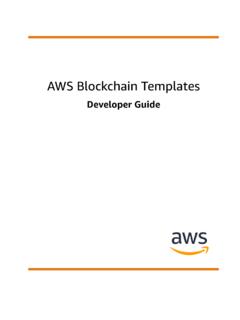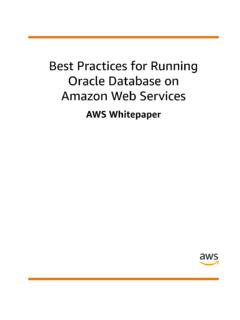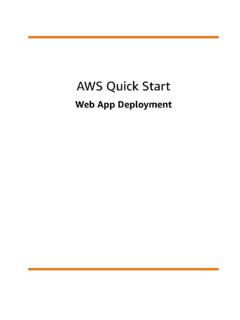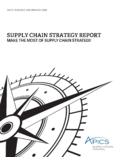Transcription of Creating a Culture of Cost Transparency and …
1 Creating a Culture of CostTransparency and AccountabilityAWS WhitepaperCreating a Culture of Cost Transparencyand Accountability AWS WhitepaperCreating a Culture of Cost Transparency and Accountability: AWSW hitepaperCopyright 2018 Amazon Web Services, Inc. and/or its affiliates. All rights 's trademarks and trade dress may not be used in connection with any product or service that is not Amazon's, in any mannerthat is likely to cause confusion among customers, or in any manner that disparages or discredits Amazon. All other trademarks notowned by Amazon are the property of their respective owners, who may or may not be affiliated with, connected to, or sponsored a Culture of Cost Transparencyand Accountability AWS WhitepaperTable of ContentsFrom Cloud Cost to Cloud Value .. 1 Abstract .. 1 Introduction .. 1 Speed and Cost Tradeoffs .. 3 Cost is Everyone's Responsibility.
2 4 Promoting Visibility, Transparency , and Accountability .. 5 Determining Cost 6 Evangelizing Best Practices .. 8 Resources .. 9 Document 10 AWS Glossary .. 11iiiCreating a Culture of Cost Transparencyand Accountability AWS WhitepaperAbstractFrom Cloud Cost to Cloud ValuePublication date: March 2018 (Document Details (p. 10))AbstractThis is the fifth in a series of whitepapers designed to support your cloud journey. This paper seeksto empower you to maximize value from your investments, improve forecasting accuracy and costpredictability, create a Culture of ownership and cost Transparency , and continuously measure youroptimization paper discusses the tools, best practices, and tips that your organization can use to create a leancost Culture and maximize the benefits of the to the cloud is an iterative process that evolves as your organization develops new skills,processes, tools, and capabilities.
3 These skills build momentum and accelerate your migration prospect of moving to the cloud does not need to be a daunting or arduous proposition. Establishingthe right cultural foundation to build on is key to a successful migration. Because cloud services arepurchased, deployed, and managed in fundamentally different ways from traditional IT, adopting themsuccessfully requires a cultural shift as well as a technological one inside consists of the attitudes and behaviors that define how a business operates. Organizations canimprove cost optimization by promoting a Culture where employees view change as normal and welcomeresponsibility in the interest of following best practices and adapting to new technology. This is whatlean cost Culture traditional environments, IT infrastructure requires significant upfront investment and labor. Thedecision to incur these costs typically must go through multiple layers of approval.
4 In legacy IT models,IT purchases are ordered and managed through a central services model at significant s more, the sources of these costs are difficult to identify and allocate, in part because of cloud presents an entirely different situation. IT infrastructure requires more limited capitalinvestments, and labor can focus on undifferentiated work as opposed to managing infrastructure. Youcan easily spin up cloud services without IT intervention using a departmental credit card. Specialistteams are not always required to get infrastructure to a functioning state, and business units can moreeasily deploy their own technology needs. While the initial costs might be lower, they are also easier toincur. Without the right infrastructure and processes in place, costs are not always easy to s also a major difference in how cloud services and data center infrastructure are paid for.
5 If youcreate a virtual machine on a physical server in a data center, there s no inherent way to measure the costof that action. If you create this machine in the cloud, costs immediately begin to accrue. Cloud costs aretightly coupled with usage, often down to the second. Most actions have a hard-dollar cost cloud resources are easier to deploy and incur usage-based costs, organizations must relyon good governance and user behavior to manage costs in other words, they need to create a leancost Culture . This is especially important because, with the cloud and modern agile DevOps practices,implementation is a continuous cycle with new resources, services, and projects being adopted a Culture of Cost Transparencyand Accountability AWS WhitepaperIntroductionA lean cost Culture is essential when architecting cloud-based solutions and should be part of planning,design, and development.
6 Cost management should not be delegated only after the technology hasbeen , in many ways, Creating a lean cost Culture is much easier to do in the Amazon WebServices (AWS) Cloud than in the data center environment. You can closely track the costs incurred byspecific individuals, groups, projects, or functions. Your teams can share information through consolesand reports. Rich cost analytics and management tools are built into the platform, and cost-savingmanagement automation is relatively easy to implement. By using the tools, best practices, and tipsdetailed in this paper, your organization can maximize the benefits of the cloud while keeping costsunder , the goal is to move from thinking about cloud costs to understanding cloud value thereturn on investment (ROI) your organization obtains from various initiatives and workloads thatleverage the cloud. It s important to understand not just what you re spending, but the value you regetting in return.
7 A bigger bill doesn t necessarily indicate a problem if it means you re growing yourbusiness, your margins, or your , your organization needs to clearly identify key performance indicators and success factorsthat are impacted by cloud adoption. In the absence of well-identified metrics, determining success iscomplicated and it can be difficult to derive value. Examples of categories that can help define successare business agility, operational resiliency, and total cost of example of how to evaluate cloud value is by looking at unit cost. The unit can be any object ofvalue in your organization, such as subscribers, API calls, or page views. The unit cost is the total cost ofa service divided by the number of units. By focusing on reducing unit cost over time and understandinghow spending and margins are related, you can concentrate on getting more for your money. Arriving atthis level of understanding can be an incremental process.
8 Best practices that can help get you there arediscussed in the following a Culture of Cost Transparencyand Accountability AWS WhitepaperSpeed and Cost TradeoffsWith cost optimization , as with the other pillars in the AWS Well-Architected Framework, there aretrade-offs to consider, for example, whether to optimize for speed-to-market or for cost. In some cases,it s best to optimize for speed going to market quickly, shipping new features, or simply meeting adeadline rather than investing in upfront cost design decisions are directed by haste rather than data, and the temptation always existsto overcompensate just in case rather than spend time benchmarking for the most cost-optimaldeployment. This might lead to overprovisioned and under-optimized deployments. However, this is areasonable choice when you need to lift and shift resources from your on-premises environment to thecloud and then optimize in a cost optimization strategy upfront allows you to realize the economic benefits of thecloud more readily by ensuring a consistent adherence to best practices and avoiding a Culture of Cost Transparencyand Accountability AWS WhitepaperCost is Everyone's ResponsibilityAll teams can help manage cloud costs, and cost optimization is everyone s responsibility.
9 Many variablesaffect cost, and different levers can be pulled to drive operational excellence. The following are examplesof different teams that need to consider cost optimization : Engineering needs to know the cost of deploying resources and how to architect for cost optimization . Finance needs cost data for accounting, reporting, and decision making. Operations makes large-scale decisions that affect IT costs. Business decision makers must track costs against budgets and understand ROI. Executives need to understand the impact of cloud spending to help with divestitures, acquisitions,and organizational the past, few of these roles were tasked with the responsibility of understanding let alone managing IT costs. Now, stakeholders need training, policies, and tools to do this effectively. The best startingpoint is to create visibility into cloud a Culture of Cost Transparencyand Accountability AWS WhitepaperPromoting Visibility, Transparency ,and AccountabilityIn the cloud, it s easy to get into a situation where the people watching costs are not the same peopleincurring them.
10 One of the goals of Creating a lean cost Culture is turning everybody into a providing alerts, dashboards, and reports relevant to each stakeholder, you reduce the feedback loopbetween the data and the action that is required to make addition to giving stakeholders visibility, it s a good idea to encourage Transparency in other words,let teams see how others are spending showcasing trends, best practices, and opportunities forimprovement. This can help create a shared sense of ownership over cloud costs and incentivize peopleto minimize them. You can even go so far as to encourage friendly rivalries between teams to achievehigher levels of optimization through achieve true success, cost optimization must become a cultural norm in your organization. Geteveryone involved. Encourage everyone to track their cost optimization daily so they can establish ahabit of efficiency and see the daily impact of their cost savings over everyone shares the ownership of cost optimization , best practices call for someone to takeprimary responsibility for cost optimization .
